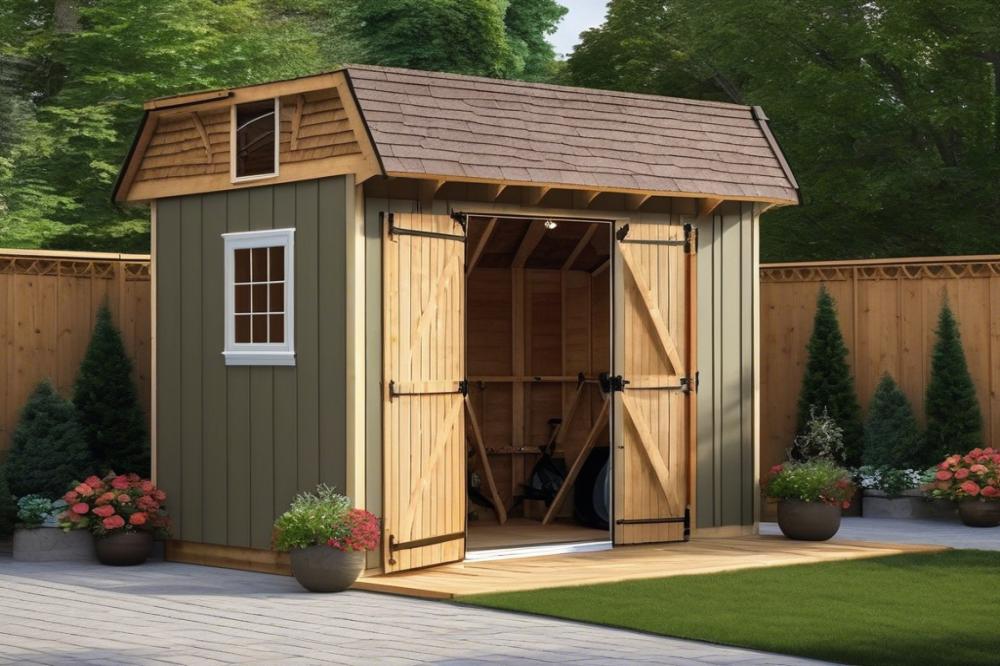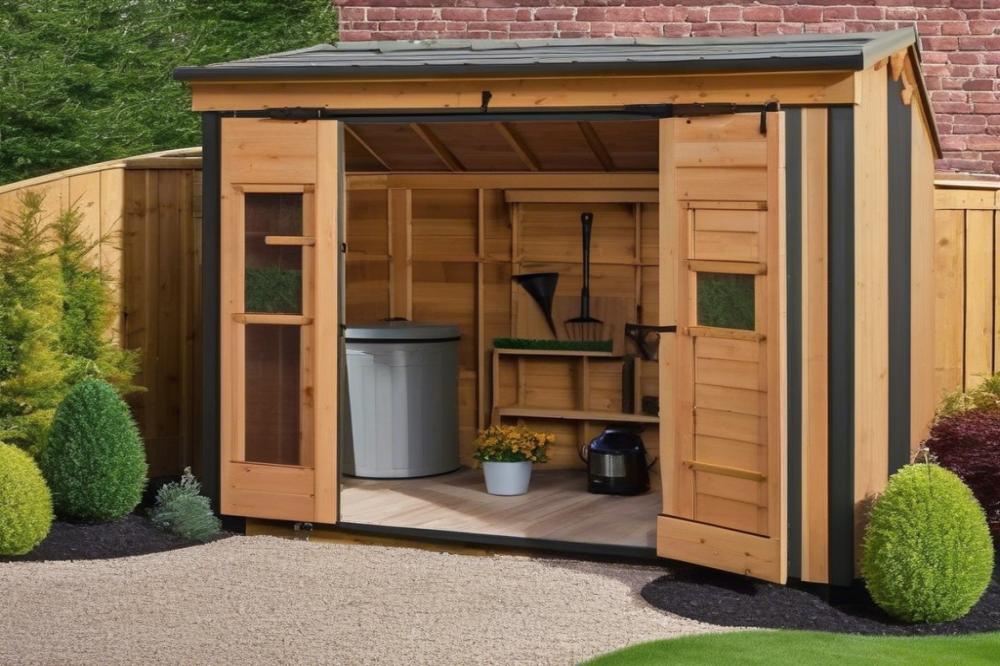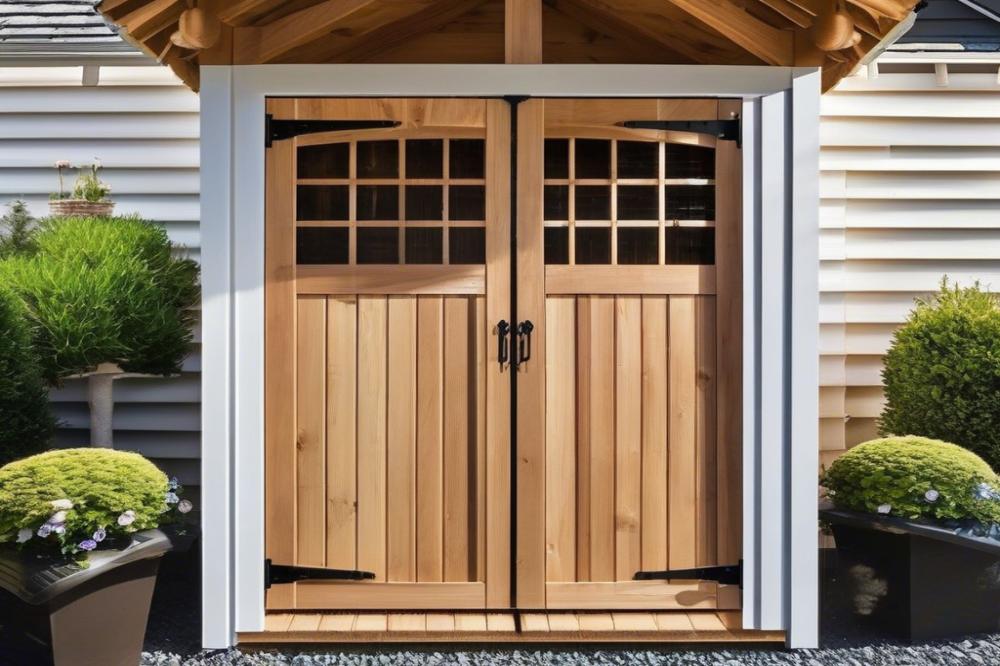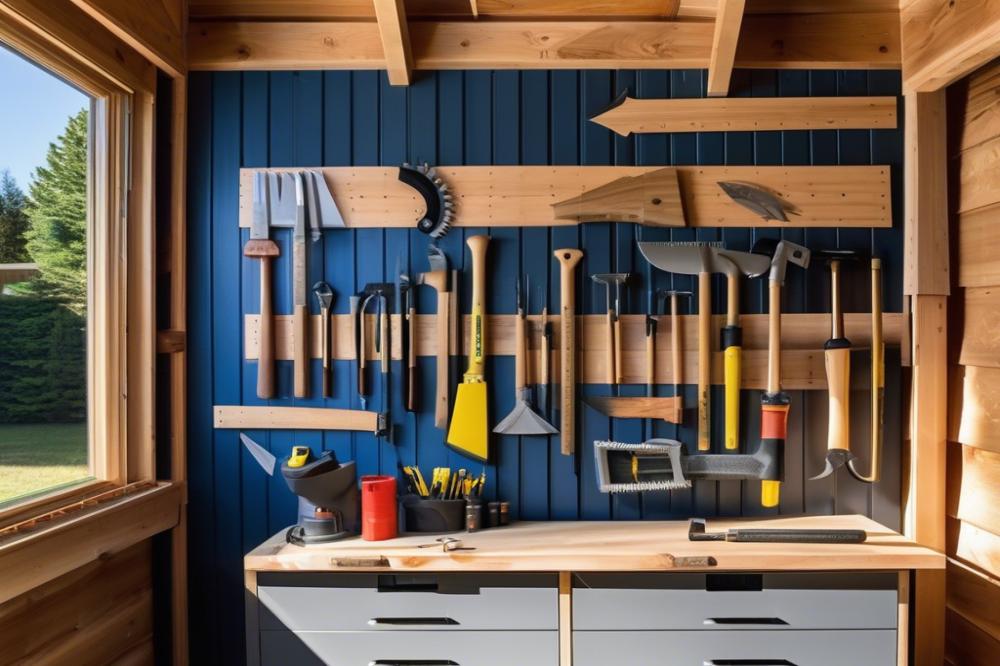Understanding the Role of a shed door
When constructing a shed, the door plays a crucial role in both functionality and aesthetics. A well-built entryway not only provides access but also enhances the overall design of the structure. Including a durable and stylish door can make your outdoor storage more inviting. Beyond its visual appeal, the door serves practical purposes. It keeps your items secure and protects them from the elements.
This article aims to guide you through all aspects of building your own entryway. With clear instructions and practical tips, you will learn how to make a shed door that meets your needs. From selecting the right shed door materials to understanding essential shed door hardware, each step will be covered in detail. Whether you want to follow shed door plans or develop your own unique style, this guide will provide valuable knowledge.
A shed door is typically a simple yet important feature of any outdoor storage solution. It allows easy entry for tools and equipment while keeping those belongings safe from theft and weather damage. Options for shed design ideas include a classic wooden shed door, or even a rustic barn door shed. Each choice can suit your personal style and enhance the beauty of your property. Understanding these factors will help you make informed decisions when you set out to build a shed door.
Understanding Shed Door Types

When it comes to building a shed, selecting the right door is key. Different designs serve various purposes. A basic outdoor storage door can be swing or sliding, depending on the available space. Each option has unique characteristics that can enhance functionality and aesthetics.
Benefits of a Wooden Shed Door
A wooden shed door offers several advantages. For one, wood provides a classic look that fits well with various shed design ideas. Durability is another benefit; a well-constructed wooden door can last for years. This material also allows for easy customization. You can paint or stain it to match your outdoor environment. With proper maintenance, it stands up against the elements efficiently.
Introduction to the Barn Door Shed Style
The barn door shed style has gained popularity lately. Its sliding mechanism saves space and adds a rustic touch to any garden or yard. This type typically uses larger panels that roll along a track. When choosing this style, think about the overall visual appeal of your shed. A barn door can be a standout feature, making it a unique element of outdoor structures.
Comparison of DIY shed door Options Versus Pre-Made Doors
Both DIY shed door projects and pre-made doors have their pros and cons. Making your own can be rewarding if you follow proper shed door plans. You can choose specific shed door materials based on your needs and budget. Customization is also easier with a DIY approach; you have complete control over the dimensions and style. On the other hand, pre-made doors offer convenience. They often come ready to install, which saves time and effort during the shed door installation process. Consider your skills and available time when making this choice.
Planning Your Shed Door

Considerations for Shed Door Size and Dimensions
Choosing the right size is crucial for functionality. Measure the shed’s opening carefully. Take into account what you will store inside. If you have large items, a wider door may be necessary. Height is also important. Standard heights often work, but don’t hesitate to customize. Think about how the door will swing. Space in front of the shed matters, too. In tight areas, a sliding design might be better.
Selecting the Right Design for Your Shed
Many styles exist for a DIY shed door. A wooden shed door offers a classic look. You can opt for a simple panel door or add decorative elements. Consider the overall design of your outdoor space. A barn door shed can offer rustic charm and easy access. Think about color and finish as well. Painting or staining wood will help it blend in with your surroundings or make a bold statement.
Analyzing Shed Door Plans and Inspirations
Numerous shed door plans are available online. Review these to find ideas that spark inspiration. Many websites showcase step-by-step tutorials. Look for photos that help visualize each option. Analyzing different designs can guide your decision. Save examples that catch your eye. This collection of ideas will ease the planning process.
Essential Shed Design Ideas that Incorporate Doors
Doors can enhance the overall appearance and functionality. Use double doors for larger access points. Consider adding windows for natural light and ventilation. Incorporating shelving inside lets you utilize the space more effectively. For outdoor storage door designs, weatherproofing is key. Strong shed door materials ensure longevity and durability. Finally, adding hardware like sturdy hinges maintains performance over time. Enjoy the building process!
Choosing Shed Door Materials

Building a DIY shed door means selecting the right materials. Each option has different characteristics that can affect the final product. Common choices are wood, metal, and composite materials.
Overview of Various Materials Suitable for a Shed Door
Wooden shed doors are traditional and offer natural beauty. They can be cut and shaped easily, making them a favorite among DIY enthusiasts. Metal doors provide increased security but can be heavier. Composite materials combine the advantages of wood and plastic. They resist weather damage while remaining lightweight.
Advantages and Disadvantages of Wood, Metal, and Composite Materials
Wood comes with a classic look. It fits many shed design ideas. However, it can warp or rot if not treated properly. Metal is sturdy and offers protection against animals and intruders. Its downside is that it may rust over time in wet climates. Composite materials resist moisture and decay. Yet, they can be more expensive upfront.
Recommendations for Weather-Resistant Materials
When you need weather-resistant materials, choose wisely. A well-treated wooden shed door can stand up against rain, but regular maintenance is necessary. Metal doors coated with paint or anti-corrosion materials last longer in harsh conditions. Using composite materials is a smart choice for those wanting less upkeep.
How to Select Materials Based on Shed Location and Climate
Consider your shed’s location when selecting materials. If your shed sits in a dry area, wood might be excellent. However, for humid climates, look at metals or composites. If there are strong winds, heavier materials can help. Think about your shed door hardware, as this will also influence your material choices.
Understanding your climate ensures a more durable door choice. Being aware of seasonal changes will guide you. Plan ahead, and your shed door will serve you well for many years. Whether you want a simple design or a barn door shed, choose materials that fit your needs.
Assembling Your Shed Door

Creating a DIY shed door involves careful planning and precise execution. To begin, gather all necessary tools and equipment. You’ll need a saw, a measuring tape, a square, a level, screws, hinges, and a drill. Additionally, materials such as plywood or solid wood for the frame are essential. Consider using pressure-treated wood for added durability. Familiarity with proper shed door plans will also help streamline your process.
Instructions on Cutting, Framing, and Constructing
Start by measuring the door frame’s opening. This measurement helps you determine the size of your door. Choose your lumber for the frame. Cut the top, bottom, and side pieces to the appropriate lengths. A square ensures your cuts are straight and precise. Assemble these pieces into a rectangular frame. Secure them using wood screws. This provides a solid structure for your outdoor storage door.
The next phase involves attaching the plywood or solid wood panel to the frame. Make sure to cut the panel precisely to fit within the frame. Affix it with screws, ensuring a tight fit. Consider additional reinforcements for larger doors. This could be diagonal bracing for added strength. If your shed design ideas include a more decorative approach, you might want to use stiles and rails for a classy finish.
Tips for Ensuring Durability and Functionality
To enhance durability, apply a weather-resistant seal to all exposed wood. This helps protect the structure from water and insect damage. When installing shed door hardware, choose high-quality hinges and locks. These components are essential for smooth operation and security. Pay attention to placement to avoid any misalignments that could cause issues later.
Lastly, test the door’s functionality before finalizing the installation. Ensure it swings freely and closes securely. Adjust hinge placement if needed. In conclusion, assembling a wooden shed door is straightforward with the right approach. The correct materials and attention to detail will create a functional addition to your shed. Remember, taking your time and following your plans carefully will produce a successful outcome.
Installing Your Shed Door
Embarking on the journey of installing your DIY shed door can feel quite rewarding. Yet, it’s essential to follow specific steps to avoid mistakes. The first step is to gather all shed door materials. A proper preparation sets the stage for success.
Guidance on Shed Door Installation Process
Begin by measuring the door frame accurately. Your dimensions will help dictate how to make a shed door that fits perfectly. Level the area where the door will hang. This ensures easier operation later on. Position your door to check if it swings open and closes without obstruction. Proper alignment here saves effort down the line. Don’t rush this initial setup – take your time to get it right.
Choosing the Right Shed Door Hardware
Selecting the correct shed door hardware is crucial to the door’s functionality. You will find various options, each serving unique needs. Consider heavy-duty hinges if the door is large or made from thick wood. A good lock provides security for your outdoor storage door. No one wants unwanted guests accessing tools or supplies. Barn door shed styles often use sliding mechanisms—research the right ones for your design ideas.
Instructions for Attaching Hinges and Locks
To attach hinges, position them on one side of the door. Mark the spots for screws with a pencil. Then, drill pilot holes to prevent cracking the wood. Next, align the hinges and screw them in place securely. For added strength, use at least three hinges on a heavier wooden shed door. When adding a lock, follow the manufacturer’s instructions closely. Ensure that the latch fits snugly into the doorframe for optimal security.
Safety Measures During Installation
Safety should always be a priority during installation. Wear protective gloves while handling sharp tools and materials. Additionally, goggles can protect your eyes from flying debris. Keep your workspace orderly to avoid accidents. When using power tools, make sure to follow the manufacturers’ guidelines. Avoid distractions while working; staying focused prevents mishaps.
Every step of this installation builds towards a sturdy and functional entryway. With proper planning and care, your shed door will serve you well for years to come.
Maintaining Your Shed Door
Taking care of your outdoor storage door is important for making it last long. Regular maintenance can prevent larger issues from arising. Here are some necessary tips to help you keep it in good shape.
Necessary Maintenance Tips for Ensuring Longevity
Wooden shed doors can warp or crack due to changing weather. Applying a protective sealant every couple of years helps. Check for peeling paint and touch up any areas to prevent moisture damage. Cleaning the surface regularly is also key. Use soapy water and a soft cloth to wipe it down. Remove dirt and grime, which can wear the door down over time.
How to Repair Common Issues with Shed Doors
Sometimes, your DIY shed door might stick or not close properly. Inspect the hinges and tighten any loose screws. If the door is misaligned, shimming it may help. Often, a bit of sandpaper can fix sticking issues where paint has built up. If you notice deep scratches or dents, consider using wood filler. Ensure it dries completely and sand it smooth before painting again.
Seasonal Checks and Upkeep for Outdoor Storage Doors
Seasonal checks can keep your shed door in top condition. Before winter, inspect for cracks and apply weather stripping if needed. Ensure hinges are lubricated to prevent rusting. In spring, check for any signs of springtime moisture and repair any damage. Using solid shed door materials will add durability, making seasonal upkeep easier. Think about your shed design ideas; well-designed doors can simplify maintenance tasks.
While the installation of your barn door shed is vital, keeping it functional is crucial too. Always have some shed door hardware on hand for quick repairs. Hinges, latches, and screws should be checked and replaced as necessary. A little time spent on maintenance goes a long way in preserving your wooden shed door.
Wrapping Up Your Shed Door Journey
Building your own shed door is a rewarding project that combines practicality with personal touch. We discussed important steps like measuring accurately and selecting the right materials. These basics will help you create a sturdy door that fits perfectly and operates smoothly. Remember to take your time while working through the process; patience pays off.
Have you thought about how a door can add character to your shed? Exploring creative designs can transform the look of your outdoor storage. From traditional styles to modern touches, the options are endless. Maybe you could paint it a bright color or add decorative hardware. Such choices can make a standard structure stand out.
Ultimately, a well-constructed door improves not just functionality but also the overall aesthetic of your outdoor area. As you use these DIY shed door techniques, consider different designs to match your personal style. Shed door plans are available online and may inspire your next project. With the right approach, your functional storage space can also become a charming addition to your yard.



